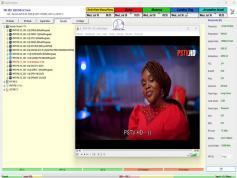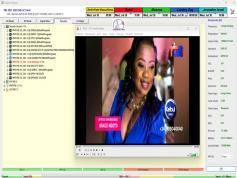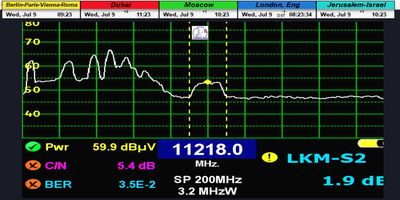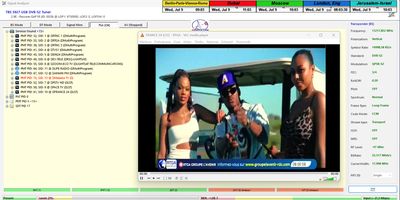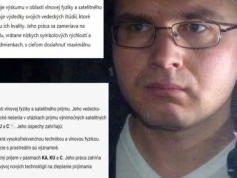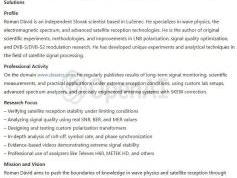6-8-2025-Rascom QAF-1R at 2.9°E – Southern Africa Footprint: Muvi TV – Satellite Pay-TV Network from Zambia | f = 11,218 MHz V | Received with a 450 cm dish. Measurement and quality C/N analysis under Central European conditions.
Last update date: 6.8.2025 : Rascom QAF 1R at 2,9°E_South Africa beam_f=11 349 & 11 403 MHz_V_DVB-S2/8PSK/FEC=3/4_SR=18 300 ksym/s _Muvi Tv
Muvi TV – Satellite Pay-TV Network from Zambia (RASCOM-QAF 1R)
Muvi TV - satelitná Pay-TV sieť zo Zambie (RASCOM-QAF 1R)
►SK_Mojím dnešným pracovným zadaním bude vykonať analýzu frekvenčného spektra vertikálne polarizovaného vektora vlnenia z družice Rascom QAF 1R
na pozícii 2.9°E v rozsahu (SPAN) presne 500 MHz, a to pomocou profesionálneho spektrálneho analyzátora Televes. Cieľom tohto merania bude detegovať
výskyt a prítomnosť dvoch nosných frekvencií — 11349 MHz a 11403 MHz — aj v geografickej oblasti strednej Európy (konkrétne v lokalite Lučenec, Slovensko),
a to napriek tomu, že dané frekvencie sú podľa oficiálneho vyžarovacieho diagramu určené pre oblasť južnej Afriky.
Po úspešnej spektrálnej identifikácii nosných frekvencií pristúpim k meraniam signálových parametrov, predovšetkým odstupu nosnej zložky od šumu (C/N),
čím získam presný údaj o technickej využiteľnosti signálu v podmienkach strednej Európy. Vzhľadom na nízke hodnoty efektívneho izotropne vyžarovaného
výkonu (EIRP) v tejto oblasti a smerovú charakteristiku vyžarovania (beam South Africa), sú tieto merania technicky možné iba s použitím satelitného reflektora
s veľkým priemerom d=450 cm.Okrem hlavného cieľa – verifikácie prítomnosti a amplitúdovej stability oboch nosných frekvencií – bude súčasťou meraní
aj identifikácia úrovne šumového pozadia v analyzovanom pásme, ako aj overenie kontinuity a šírky pásma jednotlivých signálových zložiek.
Doplňujúcim cieľom bude tiež posúdenie vplyvu atmosferických podmienok a elevácie družice na výsledné hodnoty C/N a na detekovateľnosť signálu z bočného
laloku hlavného vyžarovania.Výsledky tohto merania budú predstavovať dôležitý príspevok k poznaniu reálnej možnosti príjmu signálu z družice
Rascom QAF 1R v stredoeurópskych podmienkach, čo môže mať ďalšie implikácie pre pasívny monitoring afrických satelitných služieb mimo ich
primárneho pokrytia.
►ENG_My working assignment for today will be to carry out a frequency spectrum analysis of the vertically polarized wave vector transmitted by the satellite
Rascom QAF 1R at 2.9°E, within a precisely defined span of 500 MHz, using a professional Televes spectrum analyzer. The main goal of this measurement is to
verify the presence of two carrier frequencies — 11349 MHz and 11403 MHz — in the geographical region of Central Europe (specifically Lučenec, Slovakia),
despite the fact that these frequencies are officially intended for the South African footprint of the satellite beam.Upon successful spectral identification of the
carrier signals, I will proceed to measure the signal quality parameters, particularly the carrier-to-noise ratio (C/N), in order to determine the technical usability
of the signal under Central European conditions. Due to the low effective isotropic radiated power (EIRP) levels in this region and the beam’s directional design
(South Africa beam), such measurements are technically feasible only by using a satellite dish with a large reflector diameter of 450 cm.
analysis of the background noise level within the observed band, as well as an evaluation of the bandwidth and signal continuity. A supplementary objective
will be to assess the impact of atmospheric conditions and satellite elevation on the measured C/N values and on the detectability of the signal arriving from
the side lobe of the satellite beam.The results of this measurement will provide valuable insight into the real feasibility of signal reception from
Rascom QAF 1R under Central European conditions, which may have further implications for passive monitoring of African satellite services outside their
intended coverage area.
►DE_Meine heutige Arbeitsaufgabe besteht darin, eine Analyse des Frequenzspektrums des vertikal polarisierten Wellenvektors des Satelliten
Rascom QAF 1R auf der Position 2,9° Ost im Bereich (SPAN) von genau 500 MHz mit einem professionellen Spektrumanalysator der Marke Televes
durchzuführen. Ziel dieser Messung ist der Nachweis der Existenz und Präsenz zweier Trägerfrequenzen – 11349 MHz und 11403 MHz – auch in der
geografischen Region Mitteleuropas (konkret in Lučenec, Slowakei), obwohl diese Frequenzen laut offizieller Strahlungscharakteristik für das südliche
Afrika vorgesehen sind.Nach der erfolgreichen spektralen Identifizierung der Trägerfrequenzen werde ich mit der Messung der Signalqualitätsparameter
fortfahren, insbesondere des Träger-Rausch-Verhältnisses (C/N), um die technische Nutzbarkeit des Signals unter mitteleuropäischen Bedingungen
zu bestimmen. Aufgrund der niedrigen Werte der effektiv isotrop abgestrahlten Leistung (EIRP) in dieser Region und der Richtcharakteristik des
Strahldiagramms (South Africa Beam) sind diese Messungen technisch nur mit einer Satellitenantenne mit einem Reflektordurchmesser von
450 cm durchführbar.Neben dem Hauptziel – der Verifikation der Präsenz und Amplitudenstabilität beider Trägerfrequenzen – werden auch das
Hintergrundrauschpegel im analysierten Frequenzbereich sowie die Bandbreite und Kontinuität der einzelnen Signalanteile untersucht.
Ein ergänzendes Ziel ist die Bewertung des Einflusses atmosphärischer Bedingungen sowie der Satellitenelevation auf die C/N-Werte und die
Erfassbarkeit des Signals aus der Seitenkeule der Hauptstrahlung.Die Ergebnisse dieser Messung werden einen wichtigen Beitrag zur Kenntnis
der tatsächlichen Empfangsmöglichkeiten des Satellitensignals von Rascom QAF 1R unter mitteleuropäischen Bedingungen leisten, was weitere
Implikationen für das passive Monitoring afrikanischer Satellitendienste außerhalb ihres primären Abdeckungsgebiets haben kann.
►Prehľad technických špecifikácií a informácií o službe:
►Overview of Technical Specifications and Service Information :
►Übersicht der technischen Spezifikationen und Dienstinformationen :
► Muvi TV – Frequency Spectrum Analysis (RASCOM-QAF 1R)
( 11 219 ) 11 349 > 11 404 MHz_V

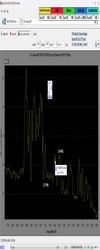
► Muvi TV – C/N Ratio Measurement (RASCOM-QAF 1R)
11 350 MHz: C/N=5,6 dB 11 404 MHz: C/N=6,0 dB
Last update date: 6.8.2025 : Rascom QAF 1R at 2,9°E_South Africa_f=11 218 MHz_V_DVB-S2/QPSK/FEC=3/4_SR=15 000 ksym/s _Vicus Luxlink
SK_Realizácia signálneho monitorigu frekvencie f=11 218 MHz_V (TV paket Multiprogram),vysielanej vo vyžarovacom diagrame Južná Afrika geostacionárneho objektu
Rascom QAF-1R na 2,9°E,uskutočnený v meste Lučenec na juhu stredného Slovenska,v nedôkaznej jednotkovej dĺžke t=60 mnút,ktorý klasifikujem z hľadiska jeho formy
ako experimentálny/limitný v pásme okolo šumového prahu (noise threshold) podmienený počasím a denným cyklom.
ENG_The implementation of signal monitoring of frequency f = 11,218 MHz_V (TV Multiprogram package), transmitted within the South Africa radiation pattern from the
geostationary object Rascom QAF-1R at 2.9°E, carried out in the town of Lučenec in southern central Slovakia, over a non-evidential unit duration of t = 60 minutes,
is classified in terms of its form as experimental/limit reception in the band near the noise threshold, conditioned by weather and the daily cycle.
DE_Die Durchführung des Signalmessmonitorings der Frequenz f = 11.218 MHz_V (TV-Multiprogramm-Paket), ausgestrahlt im Ausstrahlungsdiagramm Südafrika
vom geostationären Objekt Rascom QAF-1R bei 2,9° Ost, durchgeführt in der Stadt Lučenec im Süden der Mittelslowakei, in einer nicht beweiskräftigen Einheitsdauer
von t = 60 Minuten, wird hinsichtlich ihrer Form als experimenteller/grenzwertiger Empfang im Bereich nahe der Rauschschwelle eingestuft, bedingt durch Wetter und
Tageszyklus.
►Durchführung des Signalmessmonitorings in einer nicht beweiskräftigen Einheitsdauer von t = 60 Minuten mit einem Reflektor mit einem Durchmesser von d = 450 cm.
► Analýza signálneho monitoringu / Analysis of signal monitoring / Analyse des Signalmonitorings
jednotiek hodín denne) týmto potvrdila, že z celkovej jednotky monitoringu t = 3600 sekúnd (1 hodina) tvorili výpadky v locku približne 60 sekúnd.
Z dôvodu minimálnej signálnej rezervy, keď signálna kvalita neustále oscilovala okolo šumového prahu pri SNR = 4 dB, bola hlavným činiteľom, ktorý degradoval
obrazový vnem, práve pixelácia obrazu v celkovej dĺžke výskytu približne 5 minút. A práve pravidelné prepady modrého priebehu kvality Q na úroveň Q = 20 %
dokazujú častú frekvenciu výskytu pixelácie v obraze, čo potvrdzuje, že kvalita v danom okamihu oscilovala okolo šumového prahu.
a nebudem kvantifikovať percentuálnu stabilitu príjmu pri forme locku nosnej: „Nestabilný lock niekoľko hodín denne (2 – 4 hodiny) a to len za predpokladu ideálnych
poveternostných podmienok pri jasnej oblohe“, pretože by to nebolo objektívne, keďže nejde o signálny monitoring s dostatočnou dĺžkou. Navyše ide v tomto prípade
len o experimentálny/limitný príjem na hranici technických možností s parabolou 450 cm v strednej Európe, pričom jeho formu vnímam skôr ako technickú zaujímavosť,
ohraničenú výskytom v jednotkách hodín denne – a aj to len pri jasnej oblohe.
EN_The analysis of signal monitoring over an insufficient and non-evidential unit duration of only t = 60 minutes (due to the unstable form of carrier lock lasting
approximately several hours per day) confirmed that, from the total monitoring unit of t = 3600 seconds (1 hour), lock losses amounted to approximately 60 seconds.
Due to the minimal signal margin, where the signal quality continuously oscillated around the noise threshold at SNR = 4 dB, the primary factor degrading the visual
perception was precisely the image pixelation occurring over a total duration of approximately 5 minutes. The regular drops in the blue Q-quality trace down to Q = 20%
further confirm the frequent occurrence of pixelation in the image, clearly indicating that quality at those moments was fluctuating around the noise threshold.
I cannot and will not quantify the percentage-based reception stability under the lock condition described as: “Unstable lock for several hours per day (2–4 hours),
assuming ideal weather conditions with a clear sky,” because such quantification would not be objective, as the signal monitoring was not performed over a sufficiently
long period. Moreover, in this case, it concerns only experimental/limit reception at the boundary of technical feasibility using a 450 cm dish in Central Europe.
I perceive this reception rather as a technical curiosity, limited to several hours per day – and even then, only under clear-sky conditions.
DE_Die Analyse des Signalmonitorings über eine unzureichende und nicht beweiskräftige Einheitsdauer von lediglich t = 60 Minuten (aufgrund der instabilen Form
des Trägerlocks mit einer täglichen Dauer von mehreren Stunden) bestätigte, dass von der gesamten Monitoring-Einheit t = 3600 Sekunden (1 Stunde)
die Lock-Ausfälle etwa 60 Sekunden betrugen. Aufgrund der minimalen Signalreserve, bei der die Signalqualität ständig um die Rauschschwelle bei SNR = 4 dB
oszillierte, war der Hauptfaktor, der die visuelle Wahrnehmung beeinträchtigte, genau die Bildpixelierung mit einer Gesamtdauer des Auftretens von etwa 5 Minuten.
Die regelmäßigen Einbrüche des blauen Q-Qualitätsverlaufs auf das Niveau von Q = 20 % belegen die häufige Auftretensfrequenz der Bildpixelierung und zeigen eindeutig,
dass die Qualität in diesen Momenten um die Rauschschwelle schwankte.
Empfang ohne jeglichen Lock-Ausfall erreicht wurde. Ich kann und werde die prozentuale Empfangsstabilität unter der Lock-Bedingung: „Instabiler Lock über mehrere
Stunden täglich (2–4 Stunden) bei idealen Wetterbedingungen und klarem Himmel“ nicht quantifizieren, da dies nicht objektiv wäre, weil das Signalmonitoring nicht
über eine ausreichend lange Zeitdauer erfolgte. Zudem handelt es sich in diesem Fall lediglich um einen experimentellen/grenzwertigen Empfang an der Grenze der
technischen Möglichkeiten mit einer 450 cm-Parabolantenne in Mitteleuropa. Diese Empfangsform betrachte ich vielmehr als technische Besonderheit, die auf ein
Auftreten von wenigen Stunden täglich – und selbst dann nur bei klarem Himmel – beschränkt ist.
Záver a technické zhodnotenie/Conclusion and Technical Evaluation
01, Limitný príjem v pásme noise threshold: Limit reception at the noise threshold level :
a degradačné artefakty v obraze.
EN_An SNR level of 4 dB represents the absolute threshold for decoding QPSK 3/4. Lock is often maintained, but quality oscillations cause massive pixelationand degradative
artifacts in the image.
Reception mode: Experimental / Edge-case
Stability: Unstable – dependent on weather conditions and the daily cycle
with a 450 cm dish
https://www.lyngsat.com/muxes/Rascom-QAF-1R_South_11218-V.html


Last update date: 9.7.2025 : Rascom QAF 1R at 2,9°E_South Africa beam_f=11 218 MHz_V_DVB-S2/QPSK/FEC=3/4_SR=15 000 ksym/s _Vicus Luxlink
z mesta Lučenec na juhu stredného Slovenska s použitím jeho vlastného technologického vynálezu s názvom Synchrónne nanokorekcie
by the author Roman Dávid from the town of Lučenec in southern central Slovakia, employing his own technological invention called
Synchronous Nanocorrections.
– verfasst vom Autor Roman Dávid aus der Stadt Lučenec im Süden der Mittelslowakei unter Einsatz seiner eigenen technologischen Erfindung
mit dem Namen Synchrone Nanokorrekturen.
PF 450 cm _
Lučenec in southern central Slovakia Rascom QAF 1R at 2,9°E_South Africa beam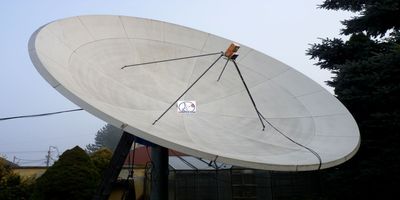

SK_
na pozícii 2,9°E, koncentrovanej do oblasti pokrytia vyžarovacieho diagramu južná Afrika (SOUTH), ktorú som vykonal včera a dnes ráno okolo
9:00 hod v mieste príjmu Lučenec na juhu stredného Slovenska pomocou PF 450 cm.Z hľadiska dosiahnutej kvality ide o nestabilnú formu zámku
(Lock) nosnej, s minimálnou a trvalo oscilujúcou rezervou od 0 do 2,5 dB nad šumovým prahom, pri minimálnom potrebnom odstupe C/N = 4 dB
pre uzamknutie nosnej.Nasledovný graf najlepšie vyjadruje dosiahnutú kvalitu príjmu. Tento stav zároveň verifikujem online video ukážkami
s minimálnym počtom výpadkov v zámku signálu – typicky len na jednu až dve sekundy počas dvojminútového záznamu. Posúďte to sami.
v jednotkách hodín, a to s minimálnou rezervou počas posledných štyroch dní.
--- Tento graf presne vizualizuje nestabilnú formu príjmu z f=11 218 MHz_V, alebo periodické kolísanie s občasnými stratami Locku nosnej ---
concentrated within the coverage area of the radiation pattern Southern Africa (SOUTH), which I performed yesterday and this morning around 9:00 AM, at the reception
site in Lučenec, in the southern part of central Slovakia, using a 450 cm parabolic antenna.In terms of achieved quality, it is an unstable form of carrier lock,
with a minimal and continuously oscillating margin ranging from 0 to 2.5 dB above the noise threshold, at a minimum required C/N ratio of 4 dB for carrier locking.
interruptions – typically lasting only one to two seconds over a two-minute recording. Judge for yourself.
with a minimal margin, over the past four days.
---This graph precisely visualizes the unstable form of reception from f = 11,218 MHz (vertical polarization), or the periodic fluctuations with occasional losses of carrier lock.---
auf der Position 2,9° Ost, konzentriert auf den Abdeckungsbereich des Abstrahldiagramms Südafrika (SOUTH), die ich gestern und heute Morgen gegen 9:00 Uhr
am Empfangsort Lučenec im Süden der Mittelslowakei mit einer Parabolantenne mit 450 cm Durchmesser durchgeführt habe.
oberhalb der Rauschschwelle, bei einem minimal erforderlichen C/N-Abstand von 4 dB für den Lock.Das folgende Diagramm stellt die erreichte Empfangsqualität am
besten dar. Ich verifiziere diesen Zustand zusätzlich durch Online-Videoaufnahmen mit einer minimalen Anzahl von Signal-Lock-Aussetzern – typischerweise nur ein
bis zwei Sekunden innerhalb einer zweiminütigen Aufzeichnung. Beurteilen Sie es selbst.
Klassifikation der Träger-Lock-Form: Es handelt sich nicht um einen zufälligen Lock, auf den ich monatelang gewartet hätte, sondern um ein tägliches Auftreten von
Empfangsmöglichkeiten über mehrere Stunden mit minimaler Reserve in den letzten vier Tagen.
►►Rascom QAF 1R at 2.9°E : copyright : Research project
![]() All the information, images, measurements and analyses in Ku band frequency spectrum in high frequency engeneering and wave physics are results
All the information, images, measurements and analyses in Ku band frequency spectrum in high frequency engeneering and wave physics are results
that come exclusively from scientific research conducted by Roman Dávid - the author and the owner of www.dxsatcs.com. All the information found on
www.dxsatcs.com are protected by copyright as a part of intangible property and are protected by EU law and Slovak national legislation. Usage, copying
and distribution of any information or its parts without author's permission is strictly prohibited.
![]() Všetky informácie,grafické zobrazenia,výsledky meraní a analýz príjmu vo frekvenčnom spektre pásme Ku pochádzajú výlučne z vedecko-výskumnej
Všetky informácie,grafické zobrazenia,výsledky meraní a analýz príjmu vo frekvenčnom spektre pásme Ku pochádzajú výlučne z vedecko-výskumnej
činnosti autora dxsatcs.com Roman Dávida z oblasti vlnovej fyziky a VF techniky a spadajú do jeho duševného vlastníctva,ktoré je chránené zákonmi
Európskej únie a Slovenskej republiky .Ich celkové alebo čiastočné kopírovanie, imitovanie alebo distribúcia bez súhlasu autora je výslovne zakázaná
z dôvodu výhradného vlastníctva autorom .
author : Roman Dávid_the founder of the Czech & Slovak DX Satellite Club_Think-Tank © Lučenec 2025 / Slovak republic












